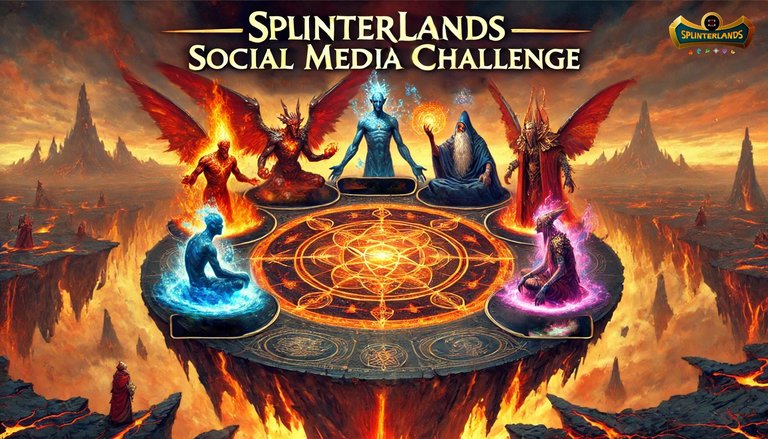
When I first discovered Splinterlands, I was instantly hooked by the thrill of battling, collecting new cards, and strategizing my way to victory. But, over time, I started to wonder: what keeps new players from sticking around after the initial excitement fades? And, perhaps more importantly, how can we, as a community, help ensure the long-term health of the game?

It’s not just big rewards and flashy gameplay that matter—although those certainly help! What really keeps players engaged is the deeper experience—the sense of progress, strategy, and connection to the community. As Splinterlands continues to evolve, here’s what I think we need to focus on to bring in new players and keep them coming back for more.
Strategic Depth: The Secret to Longevity
One of the biggest reasons I keep playing Splinterlands is the constant need for tactical thinking. Each battle feels different, even after hundreds of matches. The depth of strategy—whether it’s analyzing mana caps, understanding abilities, or anticipating your opponent’s next move—creates endless replayability.
New players need to feel this. While flashy cards and rewards may draw them in initially, it’s the strategic depth that will hook them for the long run. To ensure they get a taste of it early, we could improve tutorials and early game experiences. Give them small wins early on, then slowly increase the complexity. Once they feel the thrill of outsmarting an opponent with a well-planned strategy, they’ll be much more likely to stay.

Guild Battles and Collaboration: Strength in Numbers
Let’s be honest—playing with friends or working with a guild is a huge motivator. Guild battles add a whole new layer of competition and camaraderie that’s hard to find in other games. It’s not just about winning for yourself; it’s about contributing to something larger, and that creates a sense of belonging.
But here’s where we can improve: Guild Collaboration needs more depth. Imagine if we had guild-based events, like cooperative raids or special seasonal challenges where guild members have to work together to defeat a powerful enemy or achieve a common goal. Guild alliances could also be an incredible addition, allowing smaller guilds to team up with larger ones to take on bigger challenges or participate in more impactful events. These types of features can deepen the social aspect of the game, which is a huge factor in player retention.

The Missing Ingredient: Achievements and Quests
As players, we thrive on a sense of achievement. It’s that dopamine hit when we complete a difficult quest or earn a spot on the leaderboard that keeps us coming back. While Splinterlands gives us some of this already—through ranking up, tournaments, or card collecting—I believe there’s a whole world of untapped potential in achievements and quests.
Imagine a system where players could earn badges or exclusive rewards for completing specific in-game challenges. Think about how satisfying it would be to earn an achievement for playing with Water Splinter five times in a row, or for trampling three monsters in one turn. These kinds of challenges push us to experiment with new strategies and offer rewards beyond just ranking up.
The rewards for these achievements don’t have to be huge—something as small as 1000 GLINT or 3 SPS could motivate players to go after these tasks. And of course, the more challenging the achievement, the bigger the payout. These incremental rewards, tied to unique accomplishments, give players new goals to work toward and keep them engaged in the long term.

Improving the Game’s Economy: Meaningful Rewards
Let’s talk rewards. Splinterlands already does a great job of rewarding players with DEC, cards, and SPS, but there’s room to expand. By tying new achievements and quests to GLINT and SPS rewards, we can diversify how players are incentivized to complete tasks. Imagine getting a small GLINT reward for something like defeating tree guild mates in a ranked battle, or earning SPS for completing a week-long event challenge.
Not only does this encourage players to stay active, but it also helps improve the game’s economy by giving more utility to these tokens. When achievements or quests are tied to unique rewards that aren’t just “win-based,” it keeps more casual players engaged as well, giving them something to strive for outside of ranked battles or tournaments
Conclusion
Bringing new players into Splinterlands—and keeping them—requires us to think beyond just rewards and rankings. We need to focus on what makes a game truly engaging: strategic depth, community collaboration, meaningful achievements, and a robust economy.
By expanding the guild system, adding skill trees and challenges, and introducing unique achievements with token-based rewards, we can give players more to strive for, both in the short and long term. And that’s what will not only attract new players but keep them invested for years to come.
As we continue to grow the Splinterlands community, let’s make sure we’re building a game that offers more than just momentary excitement—let’s build one that offers endless possibilities for growth, connection, and achievement.

If you wonder what is the best way to get involved you can use my link to begin your Splinterlands and HIVE journey.
